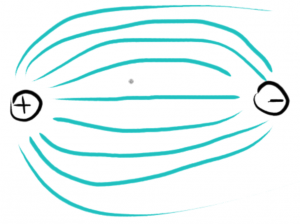Electric Fields – (Part 2 of 2)
Part 1 of Electric Fields is here: Electric Fields (Part 1 of 2)
- Fe = K | q1 q2 | / r2

- The further away, the weaker the electric fields force becomes.
- Eventually, the force won’t be attracted enough, and it won’t reach the opposite charge:

Electrical Potential Energy
Remember that Pe = m . g . h
Pe = Gravitational potential energy
m is the mass, g is gravity, and h is the height
- Work = Force of Gravity (Fg) × Height (h)
- W = Fg × h
Electrical potential energy is very similar to gravitational potential energy.
For example:
- Moving A to position B
- Electric field strength: E = 5 N/c
- Field force = Ff = 5 N/c × 2 c = 10 N
- Distance between A, and B is 3 meters
↑ . A (+2 c) ↑ ↑ ↑ ↑ ↑
↑ . B (+ 2c) ↑ ↑ ↑ ↑ ↑
_____________________________
< ++++++++++++++++++++++++++ > (this is an infinite plate)
Q. How much work does it take to move a +2 c charge, down 3 meters?
The plate is positively charge – as is the ‘floating’ charge, so these forces will repel each other.
- Total upward force:
- Ff = 5 N/
c× 2c= 10 N - Work = 10 N × 3 m
- Work = 30 N/m = 30 J of energy
The electrical potential energy: Pe (Pa relative to Pb) = 30 J
This is NOT electric potential – this is electrical potential energy
Electric potential = work / charge = 30 J / 2 c = 6 J/c = 6 V (Volts, Voltage)





You must be logged in to post a comment.